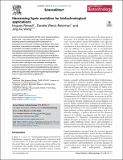| dc.contributor.author | Weng, Jing-Ke | |
| dc.date.accessioned | 2020-04-29T13:11:21Z | |
| dc.date.available | 2020-04-29T13:11:21Z | |
| dc.date.issued | 2019-04 | |
| dc.identifier.issn | 0958-1669 | |
| dc.identifier.uri | https://hdl.handle.net/1721.1/124918 | |
| dc.description.abstract | Lignin evolved concomitantly with the rise of vascular plants on planet earth ∼450 million years ago. Several iterations of exploiting ancestral phenylpropanoid metabolism for biopolymers occurred prior to lignin that facilitated early plants’ adaptation to terrestrial environments. The first true lignin was constructed via oxidative coupling of a number of simple phenylpropanoid alcohols to form a sturdy polymer that supports long-distance water transport. This invention has directly contributed to the dominance of vascular plants in the Earth's flora, and has had a profound impact on the establishment of the rich terrestrial ecosystems as we know them today. Within vascular plants, new lignin traits continued to emerge with expanded biological functions pertinent to host fitness under complex environmental niches. Understanding the chemical and biochemical basis for lignin's evolution in diverse plants therefore offers new opportunities and tools for engineering desirable lignin traits in crops with economic significance. | en_US |
| dc.description.sponsorship | Searle Scholars Program (Grant 15-SSP-162) | en_US |
| dc.description.sponsorship | National Science Foundation (U.S.) (Grant 1709616) | en_US |
| dc.language.iso | en | |
| dc.publisher | Elsevier BV | en_US |
| dc.relation.isversionof | 10.1016/j.copbio.2018.10.011 | en_US |
| dc.rights | Creative Commons Attribution-NonCommercial-NoDerivs License | en_US |
| dc.rights.uri | http://creativecommons.org/licenses/by-nc-nd/4.0/ | en_US |
| dc.source | Elsevier | en_US |
| dc.subject | Biotechnology | en_US |
| dc.subject | Bioengineering | en_US |
| dc.subject | Biomedical Engineering | en_US |
| dc.title | Harnessing lignin evolution for biotechnological applications | en_US |
| dc.type | Article | en_US |
| dc.identifier.citation | Renault, Hugues, Danièle Werck-Reichhart and Jing-Ke Weng. “Harnessing lignin evolution for biotechnological applications.” Current Opinion in Biotechnology 56 (2019): 105-111 © 2019 The Author(s) | en_US |
| dc.contributor.department | Whitehead Institute for Biomedical Research | en_US |
| dc.contributor.department | Massachusetts Institute of Technology. Department of Biology | en_US |
| dc.relation.journal | Current Opinion in Biotechnology | en_US |
| dc.eprint.version | Final published version | en_US |
| dc.type.uri | http://purl.org/eprint/type/JournalArticle | en_US |
| eprint.status | http://purl.org/eprint/status/PeerReviewed | en_US |
| dc.date.updated | 2020-02-03T18:02:57Z | |
| dspace.date.submission | 2020-02-03T18:02:59Z | |
| mit.journal.volume | 56 | en_US |
| mit.license | PUBLISHER_CC | |
| mit.metadata.status | Complete | |
